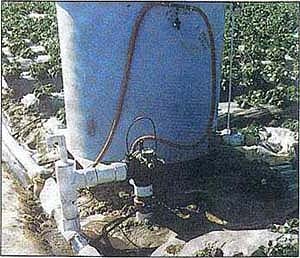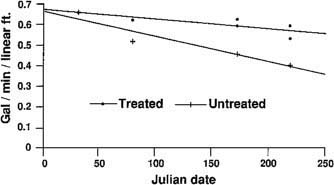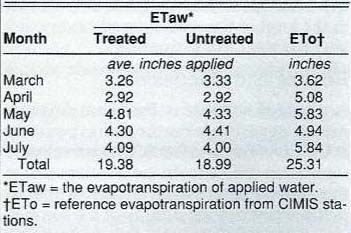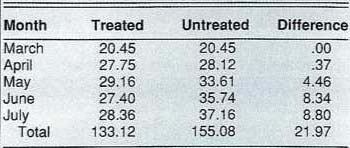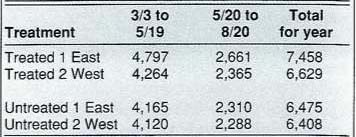All Issues
Liquid polymers keep drip irrigation lines from clogging
Publication Information
California Agriculture 45(1):24-25.
Published January 01, 1991
PDF | Citation | Permissions
Abstract
Clogging from lime (CaCO3) precipitation can be prevented by injecting a homopolymer of maleic anhydride into buried drip systems. Investigators prevented drip tubing from clogging in coastal strawberry plots by using this polymer and chlorine for high-bicarbonate waters.
Full text
This apparatus injects an experimental polymer into drip lines, inhibiting the buildup of line-clogging sediments.
Drip irrigation is practiced on one-half million (5) of California's 9 million irrigated acres, and is mostly used with annual crops. Drip systems use 3 to 15 mil thick polyethylene formed into multi-chambered V2-inch tubing with laser-drilled orifices every 8 to 16 inches. Discharge rates vary from 0.4 to 0.7 gallons per minute for 100 feet of tubing, at line pressures that range from 5 to 15 pounds per square inch (psi).
Clogging is a problem common to all drip irrigation systems, and to some extent to drip emitters and low-flow minisprinklers. The degree of seriousness is a combined function of the specific contaminants in the irrigation water and the orifice size.
Clogging is the result of particles in water, biological clogging from fungal, bacterial, or algal growth, or lime and iron precipitation.
Chemical clogging
Irrigation waters, particularly the Well waters of coastal and southern California, contain varying amounts of soluble salts that may precipitate in drip lines or emitters. As water evaporates, temperatures change in the lines, the concentrations of solutes increase, and some solutes can precipitate with increased temperature. High levels of calcium, magnesium, bicarbonate, and sulfates are of particular concern in the West. Calcium, together with bicarbonates and sulfates, can form precipitates of lime and gypsum downstream from a filter, clogging drip orifices. Clogging may be partial or complete. In the case of a partial clog, the only apparent change is a small increase in line pressure. In fact, that change in pressure can indicate a substantial decrease in water emission.
Injection of fertilizers into the drip system can enhance clogging. Fertilizers that contain calcium and phosphates have the greatest potential to clog. In contrast, liquid fertilizers containing acids can help prevent lime deposition.
The traditional method for controlling calcium and magnesium carbonate deposits has been to inject acid into the system either continuously or intermittently to reduce the pH of waters. The compound used most commonly to lower the pH of water has been sulfuric acid. Hydrochloric and phosphoric acids have also been used, but they are more expensive and pose severe handling hazards.
The search for a calcium and magnesium carbonate inhibitor led researchers to examine several commercial products. One of these is the patented homopolymer of maleic anhydride that we studied in 1989 in a strawberry drip system.
Field experiments: 1988–1989
In November 1988, we selected Gold Coast Farms of Santa Maria for the January-to-August 1989 trial. Their well water contained bicarbonate levels in the 4.0 to 4.5 Meq/L range. Within the farm, we divided a 10-acre Chandler strawberry field into four plots of 2.5 acres each. Two plots used the maleic anhydride polymer injected at 2 mg/L (2 ppm) and continuous chlorine at 1 mg/L, and the other two plots used only continuous chlorine injection.
Fig. 1. Drip tubing flow rates decrease as the season progresses. Extra clogging in the lines not treated with the liquid polymer significantly reduces their capacity to transport water to plants (1 level).
The 10-acre field was set up so each of the four sections would irrigate separately. Each section consisted of one hundred 300-foot-long rows. Water meters were installed for each plot. The grower continuously injected chlorine into each irrigation system from February 1, 1989 through August 8, 1989. The treated plots also received a continuously injected polymer treatment. The grower used soil matrix potential tensiometers to determine irrigation scheduling. Irrigation was initiated when tensiometers reached 15 cb readings at depths of 4 or 6 inches.
We read the water meters about once a week. Emitter flow and uniformity were measured on March 21, June 21, and August 7. Yield data were taken for each plot from March through May. Weekly and monthly reference evapotranspiration (ETo) data were obtained from the CIMIS weather stations in Santa Maria.
Results
The applied water data (ETaw, table 1) showed a trend of lower flow rates in the untreated plots. Figure 1 shows the flow rates of polymer-treated and untreated waters on March 1, March 21, June 21, and August 7. Emission evaluations of polymer-treated water show only slight decreases over the 6-month growing period, but untreated well waters show a decrease of nearly 50 by August. A linear regression of flow rate versus time was fitted for both treated and untreated plots. The test for equality of slopes demonstrated that the decrease in flow rate over time for untreated water was significantly greater than for treated water at the 1 level.
Conclusions
The results (table 1, fig. 1) indicate that the system injected with 2 mg/L maleic anhydride polymer supplied the actual amount of water required for plant needs, while the untreated tubing's output decreased as the season progressed. The crop water requirement (ETc) for strawberries and the flow rate differences are shown as hours of irrigation in table 2. The hours of irrigation needed to apply a given amount of seasonal water are much greater for the untreated than the treated system.
The yield from each individual plot was obtained for the period from March 1989 to May 19,1989, and the yields from the aggregated plots (10 acres), from May 20 to August 20,1989 (table 3). A yield increase of about 300 12-pound trays per 2.5 acre plot was obtained in the early season. Assuming this trend continued, an overall yield increase of about 600 trays would result where the aggregated yield was assigned to each 2.5 acre plot and added to the early season results. This suggests that the plots treated with 2 mg/L maleic anhydride polymer received the appropriate amount of irrigation water. Yields were increased and drip efficiency improved where we injected the polymer into drip irrigation lines.



